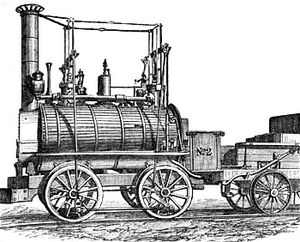Blücher (locomotive)

One of the Killingworth engines
|
|||||||||||||||
|
|||||||||||||||
|
|||||||||||||||
|
|||||||||||||||
| Type and origin | |
|---|---|
| Power type | Steam |
| Builder | George Stephenson |
| Build date | 1814 |
| Specifications | |
|---|---|
| Gauge | 4 ft 8 in (1,422 mm) |
| Loco weight | 6 tons |
| Boiler | 2 ft 10 in (864 mm) dia × 8 ft 0 in (2,438 mm) long |
| Cylinder size | 8 in × 24 in (203 mm × 610 mm) |
| Loco brake | ? |
| Train brakes | None |
| Career | |
|---|---|
| Operators | Killingworth Colliery |
George Stephenson built a number of experimental steam locomotives to work in the Killingworth Colliery between 1814 and 1826.
George Stephenson was appointed as engine-wright at Killingworth Colliery in 1812 and immediately improved the haulage of the coal from the mine using fixed engines. But he had taken an interest in Blenkinsop's engines in Leeds and Blackett's experiments at Wylam colliery, where he had been born. By 1814 he persuaded the of the colliery to fund a "travelling engine" which first ran on 25 July. By experiment he confirmed Blackett's observation that the friction of the wheels was sufficient on an iron railway without cogs but still used a cogwheel system in transmitting power to the wheels.
Blücher (often spelled Blutcher) was built by George Stephenson in 1814; the first of a series of locomotives that he designed in the period 1814–16 which established his reputation as an engine designer and laid the foundations for his subsequent pivotal role in the development of the railways. It could pull a train of 30 tons at a speed of 4 mph up a gradient of 1 in 450. It was named after the Prussian general Gebhard Leberecht von Blücher, who, after a speedy march, arrived in time to help defeat Napoleon at the Battle of Waterloo in 1815.
Stephenson carefully measured its performance and realised that overall it saved little money compared with the use of horses, even though the price of corn was at an all-time high because of the wars. He made one significant improvement by redirecting the steam outlet from the cylinders into the smoke stack, thereby increasing the efficiency of the boiler markedly as well as lessening the annoyance caused by the escaping steam.
Blücher's performance was described in the second 1814 volume of the Annals of Philosophy. The item started by recording a rack locomotive at Leeds (probably Salamanca) and continued: "The experiment succeeded so well at Leeds, that a similar engine has been erected at Newcastle, about a mile north from that town. It moves at the rate of three miles an hour, dragging after it 14 waggons, loaded each with about two tons of coals; so that in this case the expense of 14 horses is saved by the substitution of the steam-engine". The item continues to mention a locomotive without a rack wheel (probably Puffing Billy at Wylam).
...
Wikipedia
